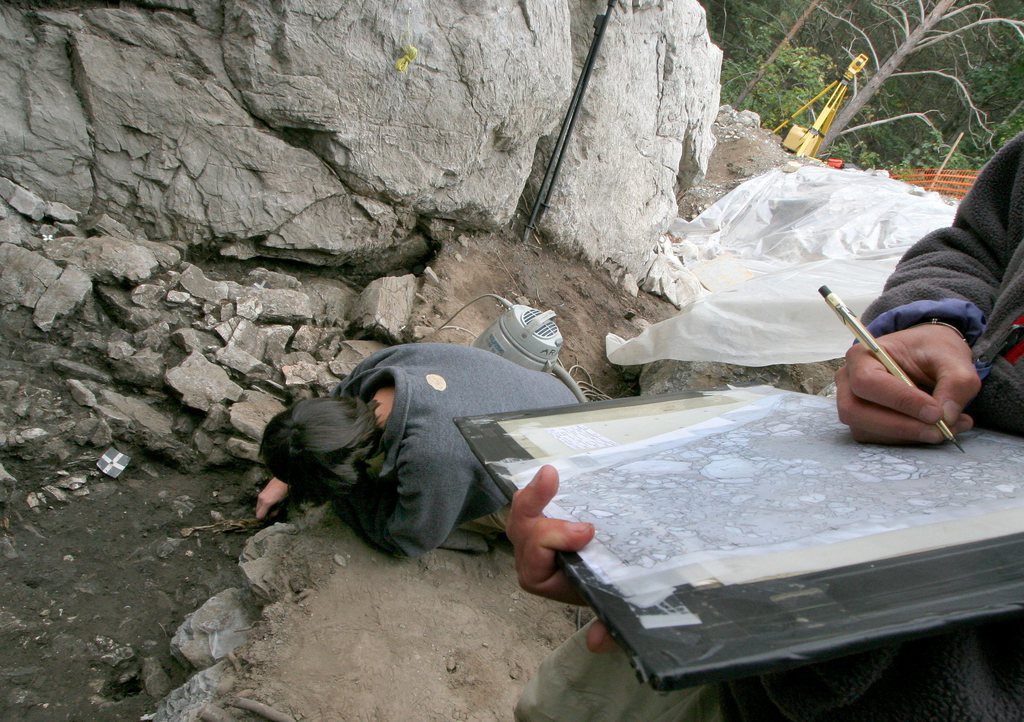
Archaeology gets a shot of science

Science has been making itself more and more felt in archaeology, a paradigm shift in the discipline that has slowly begun to erase the boundaries between archaeologists and natural scientists.
Travelling across Switzerland, especially in the summer months, it is not unusual to come across people working on an archaeological dig somewhere out in the country. But the digging, scraping and vacuuming are just one part of the job.
Once a survey is complete, what does it tell us, and what is the story behind the artefacts? Science has certainly made its impact felt in recent years, either through spectacular results or cutting-edge techniques.
“If you consider the purely technological approach, progress made by science now allows us to analyse artefacts, sites and all the most discrete traces of the past in more depth,” said Marc-Antoine Kaeser, director of the Laténium archaeological museum near Neuchâtel.
For example, the remains of a wealthy archer – dubbed the King of Stonehenge – found near the site in southern England were from the Alps. Tests on the chemical components of the archer’s tooth enamel suggested that he had come from an area that is most probably modern-day Switzerland.
The Paul Scherrer Institute in canton Aargau uses high-powered neutron and x-ray beams to analyse objects and reveal their inner structures without destroying them.
And archaeologists – arm-chair amateurs and professionals – now have a free eye in the sky, Google Earth, to help pick out potential sites for future campaigns, something they could never have afforded in the past or only at substantial cost.
Marrying sciences
Indeed, the relationship between archaeologists and other specialists is becoming much tighter.
“Over the past two decades, archaeology has been integrated into the natural sciences, as the idea that to understand a society, you need to understand its environment, has progressed,” explained Kaeser. “This was a paradigm change for archaeology.”
The biggest change that affected Swiss archaeology was a government decision reached over 50 years ago, when all costs in the field related to the construction of the national motorway network were taken over by the federal authorities, boosting research across the country.
As funding became more readily available, archaeologists began slowly to work with specialists who previously had not been involved in their research. This also meant that campaigns were not restricted to artefacts found along the path of a motorway, but that the wider context such as soil conditions were also part of studies.
Geologists are among those professions that have become involved in archaeology in recent years. They first came on board when archaeologists reached the limits of their own knowledge and began to call on them to determine if layers of earth containing artefacts were natural or man-made, especially they were older than the Gallo-Roman period.
Advanced analysis
With more advanced techniques being developed, mineralogists are now able to determine the origin of ancient ceramics and say more precisely where they were produced, providing clues to trade or migratory routes. The interpretation of the smallest traces found at a site has changed too.
“Twenty years ago, if you looked at phosphates in a cave, you could determine if bears lived there at some point in time for example,” said Luc Braillard, a geologist at Fribourg University.
“Today, we can sometimes see under an electronic scanning microscope if there are different layers and if there were different times the cave was occupied by the animals.”
Advanced analysis even allows these specialists to figure out how hot a hearth could be, giving an indication of what metals could be used and how technologically advanced a group was. Electronic scanning microscopes can also say what a tool was used for.
Environmental connection
Braillard reckons though the biggest change has been the development of a dialogue between archaeologists and geologists.
“If you take samples during a dig campaign on site and ask the right questions from the start, you avoid the problem of analysing artefacts out of context, and the discussions you have with archaeologists make the final results of our work more plausible,” he told swissinfo.ch.
Geologists now play a major role on campaigns. “Ahead of the construction of the A5 motorway near Bevaix in canton Neuchâtel, there were some people saying there were more geologists on site looking for traces of a prehistoric past than archaeologists,” added Braillard.
As technological progress and the integration of natural sciences proceeds, archaeologists are now looking beyond the notion of the single archaeological site and taking a wider view.
“Landscapes are for example the result of history and the actions of our ancestors,” Kaeser told swissinfo.ch.
“Until the Industrial Revolution, the interaction between humans and the environment was important. An appropriate management of the ecosystem was vital for the survival of the communities and the development of civilisation.”
The choice of a settlement was highly dependent on local resources and research has shown that from prehistoric times on, people planned the future development of their community through the management of the resources at hand.
Geologist Braillard says though this is more of a mind-set than reality and that everything cannot be tied up into a neat package.
“For geologists, time is not linear, but happens with gaps in between. Archaeologists don’t always understand this.”
“Everything has a story, but mankind is just one part of that story,” he added. “All the information we have concerning humans is local.”
Carbon dating : allows the dating of organic materials with the 14C isotope, an unstable form of carbon. When an organism dies, it loses 14C at a regular rate. Measuring the remaining isotope helps determine the approximate age of the sample.
Dendrochronology: a method of dating based on the analysis of patterns of tree-rings. It can date the time at which tree rings were formed, in many types of wood, to the exact calendar year.
Pedology: the study of soils in their natural environment. It looks at the interactions between climate, soil life, the mineral material of the original and added rock, and its position in the landscape.
Neutron beams: neutrons pass easily through metals and reveal substances containing hydrogen, allowing for non-destructive analysis of artefacts.

In compliance with the JTI standards
More: SWI swissinfo.ch certified by the Journalism Trust Initiative




























You can find an overview of ongoing debates with our journalists here . Please join us!
If you want to start a conversation about a topic raised in this article or want to report factual errors, email us at english@swissinfo.ch.